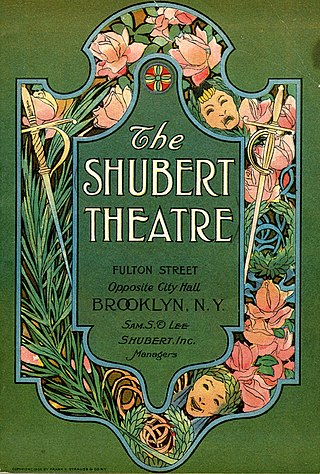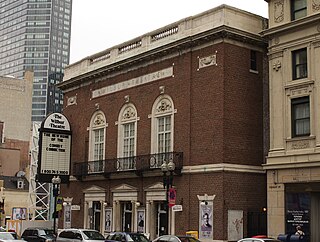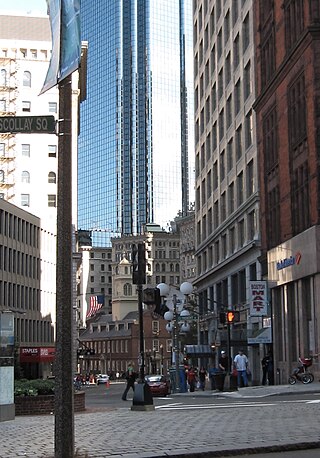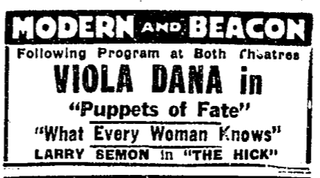
The Boch Center is a 501(c)(3) nonprofit performing arts organization located in Boston, Massachusetts. It manages the historic Wang and Shubert theatres on Tremont Street in the Boston Theater District, where it offers theatre, opera, classical and popular music, comedy, dance, and Broadway musicals. The center also offers a diverse mix of educational workshops and community activities; collaborates with artists and local performing arts organizations; and, acts as a champion for the arts in the Greater Boston community by aggressively helping to make the arts an integral part of the community's collective, daily experience. It maintains partnerships with numerous arts organizations in Boston, including the Celebrity Series of Boston, Fiddlehead Theatre Company, Express Yourself, and more.

The Wang Theatre is a theatre in Boston. It originally opened in 1925 as the Metropolitan Theatre and was later renamed the Music Hall. It was designed by Clarence Blackall and is located at 252–272 Tremont Street in the Boston Theatre District. The theatre is operated as part of the Boch Center. The theatre was designated as a Boston Landmark by the Boston Landmarks Commission in 1990.
Shubert Theatre or Shubert Theater may refer to:

The Shubert Organization is a theatrical producing organization and a major owner of theatres based in Manhattan, New York City. It was founded by the three Shubert brothers in the late 19th century. They steadily expanded, owning many theaters in New York and across the United States. Since then it has gone through changes of ownership, but it is still a major theater chain.

The Cutler Majestic Theatre at Emerson College, in Boston, Massachusetts, is a 1903 Beaux Arts style theater, designed by the architect John Galen Howard. Originally built for theatre, it was one of three theaters commissioned in Boston by Eben Dyer Jordan, son of the founder of Jordan Marsh, a Boston-based chain of department stores. The Majestic was converted to accommodate vaudeville shows in the 1920s and eventually into a movie house in 1956 by Sack Cinemas. The change to film came with renovations that transformed the lobby and covered up much of John Galen Howard's original Beaux-Arts architecture.

Abraham Lincoln Erlanger was an American theatrical producer, director, designer, theater owner, and a leading figure of the Theatrical Syndicate.

The Tremont Street subway in Boston's MBTA subway system is the oldest subway tunnel in North America and the third oldest still in use worldwide to exclusively use electric traction, opening on September 1, 1897. It was originally built, under the supervision of Howard A. Carson as chief engineer, to get streetcar lines off the traffic-clogged streets, instead of as a true rapid transit line. It now forms the central part of the Green Line, connecting Boylston Street to Park Street and Government Center stations.

Tremont Street is a major thoroughfare in Boston, Massachusetts.

The Wilbur Theatre is a historic performing arts theater at 244–250 Tremont Street in Boston, Massachusetts. The Wilbur Theatre originally opened in 1914, but underwent renovations in 2008. The Wilbur Theatre sits in the heart of Boston's historic theater district and is known for hosting live comedy and music.

Clarence Howard Blackall was an American architect who is estimated to have designed 300 theatres.

Court Street is located in the Financial District of Boston, Massachusetts. Prior to 1788, it was called Prison Lane (1634–1708) and then Queen Street (1708–1788). In the 19th century it extended beyond its current length, to Bowdoin Square. In the 1960s most of Court Street was demolished to make way for the construction of Government Center. The remaining street extends a few blocks, near the Old State House on State Street.

The Boston Opera House, also known as the Citizens Bank Opera House, is a performing arts and esports venue located at 539 Washington St. in Boston, Massachusetts. It was originally built as the B.F. Keith Memorial Theatre, a movie palace in the Keith-Albee chain. The chain became part of RKO when it was established just before the theater opened on October 29, 1928, and it was also known as the RKO Keith's Theater. After operating for more than 50 years as a movie theater, it was rededicated in 1980 as a home for the Opera Company of Boston, which performed there until the opera company closed down in 1990 due to financial problems. The theater was reopened in 2004 after a major restoration, and it currently serves as the home of the Boston Ballet and also hosts touring Broadway shows.

Tremont Row (1830s-1920s) in Boston, Massachusetts, was a short street that flourished in the 19th and early-20th centuries. It was located near the intersection of Court, Tremont, and Cambridge streets, in today's Government Center area. It existed until the 1920s, when it became known as Scollay Square. In 1859 the Barre Gazette newspaper described Tremont Row as "the great Dry Goods Street of Boston."

The Tremont Theatre was a playhouse in Boston, Massachusetts, in the late 19th and early 20th centuries. Henry E. Abbey and John B. Schoeffel established the enterprise and oversaw construction of its building at no.176 Tremont Street in the Boston Theater District area. Managers included Abbey, Schoeffel and Grau, Klaw & Erlanger, Thos. B. Lothan and Albert M. Sheehan.

B.F. Keith's Theatre (1894–1928) in Boston, Massachusetts, was a vaudeville playhouse run by B.F. Keith. It sat across from Boston Common in the city's theatre district, with an entrance on Tremont Street and another on Washington Street. Personnel included Keith, E.F. Albee and H.E. Gustin. Virgilio Tojetti painted some of the interior decorations. In 1939, the theater was converted to a movie theater named the Normandie.
The Plymouth Theatre (1911–1957) of Boston, Massachusetts, was located on Stuart Street in today's Boston Theater District. Architect Clarence Blackall designed the building for Liebler & Co. Performers included Henry Jewett, Bill "Bojangles" Robinson, 8-year-old Sammy Davis, Jr., and Bette Davis. In October 1911, the touring Abbey Theatre presented Synge's Playboy of the Western World at the Plymouth; in the audience were W. B. Yeats, Isabella Stewart Gardner and Rose Fitzgerald Kennedy.
The National Theatre (1911-1978) of Boston, Massachusetts, was a 3,500-seat multipurpose auditorium on Tremont Street in the South End. It functioned as a cinema, lecture hall, and stage. Performers included Jehovah's Witness founder Joseph F. Rutherford and "big-name entertainers like Duke Ellington and Ray Bolger." Movie screenings included The Battle of Gettysburg in 1913. The English High School held graduation exercises in the National. Around 1919 it was known as the "Waldorf Theater." In 1992, it was purchased by Philip Smith.

The Beacon Theatre was a cinema on Tremont Street in Boston, Massachusetts built in 1910 and closed in 1948. Jacob Lourie established it. Architect Clarence Blackall designed the building, with its 500-seat auditorium which a contemporary critic described as "showy." It had a staff of 26 in 1910. In 1948 the "refurbished" building became the Beacon Hill Theater. The building existed until 1970.

The Boston Theater District is the center of Boston's theater scene. Many of its theaters are on Washington Street, Tremont Street, Boylston Street, and Huntington Avenue.

Domingo Mora (1840–1911) was a Spanish-American sculptor and architectural sculptor.



















